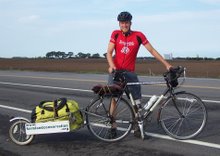In preparation for my adventure I contacted over sixty small farmers that were located within 30 miles of my main route between
Susanna was well known in
Susanna, now in her late forties, had the energy and enthusiasm of an exuberant twenty year old. She’d been raised on a corn and sheep farm in
Susanna didn’t feel good about the contribution she was making. She pleaded with her clients to fit their projects into a more natural landscape, but her ideas were too often rejected. “We were basically prostituting ourselves for the developers,” she states frankly. Disillusionment with the societal image of success and modern creature comforts comes more easily to those who feel a calling to the earth under foot. Susanna possessed that in abundance and signed up for the Peace Corps in
Spending quality time outside of the
Returning to the states was the most difficult experience of her life, but not for the reasons one might think. “It was so sad to look at people; their pasty white faces and blank stares; they just looked like zombies.” A general lack of health born from people’s eating habits, consumption habits, exercise habits and community relationships manifested itself in a person’s weight, appearance, vigor, and state of mind.
As Susanna shared her experience I considered the role reversal she was describing. Typically, Americans think of a subsistence lifestyle in a third world country as so pitiful and undesirable. I pictured living from the land contrasted with the average job working in a windowless retail store, or factory in the states. The connections to life are very direct in a subsistence culture; food, water, work, family, nature. Such contrasts begs the question, how do our trivial material goods and processed foods from so many thousands of miles away affect society?
Salamander Springs Farm is nestled in a holler of the Clear Creek basin just south of
Next morning, I was able to see firsthand what five years of steady patient work had accomplished. Susanna had taken three of her twenty five acres and blended flowers, herbs, grains, vegetables, and fruit trees with human habitats such as her shack, a produce cleaning shed, ponds, composting toilet, shower, and her small two story house. The ingenuity applied in every corner was astounding.
Electricity was virtually unnecessary. Her open air kitchen had two stoves hooked to a propane tank. Water was gravity fed from a spring box she had constructed up the hill. She listened to NPR in the mornings from a small radio powered by solar electricity. Breakfast was cornmeal mash made from her heirloom corn named “Bloody Butcher.” Fresh honey and dried currants added flavor, though the corn itself had plenty of flavor.
Susanna’s crops were all planted in less than two acres of space. Diversity was key to the absence of pests and amazingly, everything was planted by hand, with no mechanical equipment whatsoever; in other words no tilling. “Nature doesn’t till, nature builds up the soil,” she taught. What had previously been less than an inch of topsoil on top of a thick clay hardpan, had been built up to nearly 7-8 inches of loamy soil with cover crops, composted horse manure, and mulch. Tilled soil loses both carbon and nitrogen to the atmosphere, whereas a mulched bed retains moisture and nutrients and makes weeding unnecessary. Susanna hated weeding and from all appearances had very little to weed.

The name for this style of farming is called permaculture, and it encompasses more than food production. Short for “permanent agriculture” its principles include energy efficiency, waste water treatment, recycling and land stewardship. These systems were all being applied. For the next two days, I worked, ate, cleaned, and lived as close to the earth as I ever have. Most people would consider Susanna’s lifestyle an extreme way of living. She nurtured life, fed others and herself, benefited the community, and stayed true to principles she had sought throughout a lifetime. How many of us can claim that?
This brief article was written in haste for publication. My experience at Susanna's was incredibly rich and wonderful and will require extensive reflection to capture acurately. It was one of my favorite stops so far for many reasons that I look forward to capturing. Susanna, if you are out there, thank you.
This entry was posted on 7/11/2006 11:56 AM



No comments:
Post a Comment